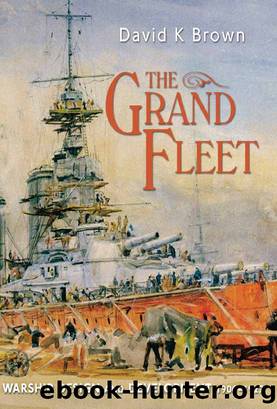The Grand Fleet by David K. Brown

Author:David K. Brown
Language: eng
Format: epub
Publisher: Seaforth Publishing
Published: 2014-07-14T16:00:00+00:00
Comparison with other navies
Only three navies built destroyers in large numbers during the war, Britain, Germany and the USA.11 There were considerable differences in style between these navies but each seems to have been well satisfied with their pre-war designs and continued to build and develop them in considerable numbers. Towards the end of the war a number of bigger and more heavily armed destroyers were built, mainly in reaction to scare stories that the enemy was building such ships. These bigger ships, such as the ‘Vs’ and ‘Ws’, formed the basis for post-war designs.
British engineers had adopted oil firing before the war and moved to geared turbines early in the war, much improving endurance and sustainable speed. Even so, the need for even more endurance was recognised and fuel stowage was increased. Freeboard and flare were increased and the bridge moved aft to improve sea keeping. The greater size of the ‘Vs’ and ‘Ws’ made them even better sea boats.
At the outbreak of war, most German destroyers had the weak gun armament of three 88mm (22pdr), but in the majority this was changed to three 4.lin (38lb shell) by 1916. Initially, most of their ships were coal-burning but full oil-firing was introduced in wartime ships; there were no geared turbine ships. Jellicoe frequently complained (see Chapter 7) that German destroyers were better sea boats but he quotes no evidence to support this unlikely view. German sources suggest that their boats with a short forecastle and a well deck forward of the bridge were very wet.12 Later boats were bigger and the forecastle was both longer and higher, but they were still inferior to their British contemporaries (see Vivien, Chapter 7)
In general, USN destroyers were bigger, partly to get the endurance needed for the Pacific but, more directly, because they were used as scouts for the battlefleet. Even in peacetime they would normally cruise at 20kts and would use full power frequently. The last pre-war ships of the ‘1000 ton’ class mounted four 4in guns and twelve torpedo tubes. Speed was just under 30kts but their endurance was 2500 miles at 20kts. The hull form had a low resistance (in still water) and a model was made and tested at Haslar. USN reports suggests that their sea keeping was inferior to the earlier ‘750 ton’ boats.13 The wartime destroyers, the famous ‘Flush Deckers’, were larger still, with the same armament and a trial speed of 35kts. Endurance was specified as 3400 miles at 20kts (5000 miles at 15kts) but much exceeded on trial by many ships.14 USN reports of their ships operating with RN destroyers in the Irish Sea claim that the Americans were the better sea boats, but this comparison is presumably with the small, pre-war British ships. Certainly, no one in the Second World War had any doubts about the superiority of the ‘V’ & ‘W’s over the ‘Towns’. The USN ships suffered from flimsy upperworks and very large turning circles, exacerbated by unreliable chain-operated steering gear.
Action damage
Download
This site does not store any files on its server. We only index and link to content provided by other sites. Please contact the content providers to delete copyright contents if any and email us, we'll remove relevant links or contents immediately.
| Africa | Americas |
| Arctic & Antarctica | Asia |
| Australia & Oceania | Europe |
| Middle East | Russia |
| United States | World |
| Ancient Civilizations | Military |
| Historical Study & Educational Resources |
1805 by Richard Woodman(851)
Labyrinth of Ice by Buddy Levy(648)
RMS Titanic by Peter Davies-Garner(610)
A Game of Birds and Wolves by Simon Parkin(521)
1812: The Navy's War by George C. Daughan(514)
Life by Tim Flannery(509)
Rogue Warrior by Richard Marcinko(507)
Naval Warfare, 1815-1914 (Warfare and History) by Lawrence Sondhaus(441)
Sontag, Sherry - Blind Man's Bluff by Sontag Sherry(439)
The Rise And Fall of British Naval Mastery by Paul Kennedy(433)
Tracing Your Merchant Navy Ancestors by Simon Wills(417)
American Naval History by Craig L. Symonds(416)
Warship 2019 by John Jordan(413)
The Supercarriers: The Forrestal and Kitty Hawk Classes by Andrew Faltum(395)
Roosevelt's Navy by James Tertius De Kay(374)
The Imperial Cruise by James Bradley(367)
The Imperial Cruise: A Secret History of Empire and War by James Bradley(364)
Men-of-War by Patrick O'Brian(362)
Modern Military Strategy by Elinor C Sloan(350)
